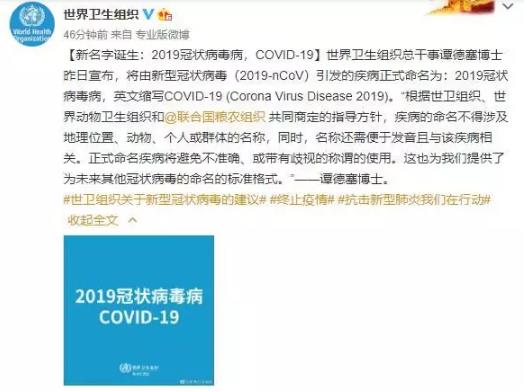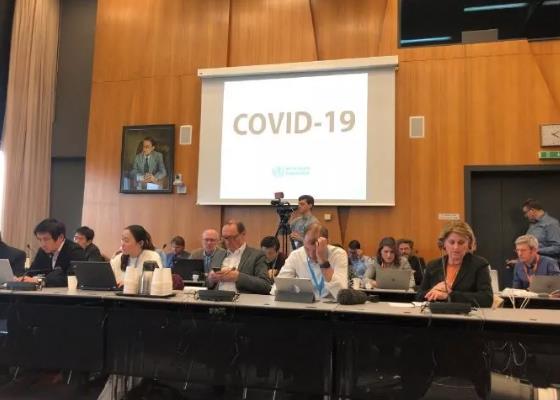世卫正式命名新冠病毒疾病为COVID-19,疾病起名有何讲究?
全球研究与创新论坛2月11在日内瓦开幕。世界卫生组织总干事谭德塞宣布,将由新型冠状病毒(2019-nCoV)引发的疾病正式命名为:2019冠状病毒病,英文缩写COVID-19 (Corona Virus Disease 2019)。
谭德塞表示,“根据世卫组织、世界动物卫生组织和联合国粮农组织共同商定的指导方针,疾病的命名不得涉及地理位置、动物、个人或群体的名称,同时,名称还需便于发音且与该疾病相关。正式命名疾病将避免不准确、或带有歧视的称谓的使用。这也为我们提供了为未来其他冠状病毒的命名的标准格式。”
此前的2月7日,中国国家卫健委将这次“新型冠状病毒感染的肺炎”暂命名为“新型冠状病毒肺炎”,简称“新冠肺炎”,英文为“Novel Coronavirus Pneumonia”,简称“NCP”。
WHO Director-General Tedros Adhanom Ghebreyesus’s Remarks at the Media Briefing on 2019-nCoV on 11 February 2020
世卫组织总干事谭德塞博士在2020年2月11日举行的2019新型冠状病毒新闻通报会上的讲话

11 February 2020
2020年2月11日
...
Now to coronavirus.
我现在讲一讲冠状病毒。
First of all, we now have a name for the disease:
首先,我们现在有了这一疾病的正式名称:
And it is COVID-19. And I will spell it: C-O-V-I-D hyphen one nine – COVID-19. CO stands for corona, you know, VI stands for virus, D stands for disease of COVID.
2019冠状病毒病(英文缩写COVID-19)。CO代表冠状,VI代表病毒,D代表疾病。
Under agreed guidelines between WHO, the World Organisation for Animal Health and the Food and Agriculture Organization, means WHO, OIE and FAO of the United Nations, we had to find a name that did not refer to a geographical location, an animal, an individual or group of people, and which is also pronounceable and related to the disease.
根据世界卫生组织、世界动物卫生组织和联合国粮食及农业组织商定的命名指南,我们必须找到既不涉及地理位置、动物、个人或人群,又容易发音,并且与该疾病相关的名称。
Having a name matters to prevent the use of other names that can be inaccurate or stigmatizing. It also gives us a standard format to use for any future coronavirus outbreaks.
妥善命名很重要,有助于防止使用其他可能不准确的或污名化的名称。它还为我们提供了今后任何冠状病毒疫情的标准命名格式。
And now to the coronavirus situation.
现在讲一下新型冠状病毒疫情。
As of 6am Geneva time this morning, there were 42,708 confirmed cases reported in China, and tragically, we have now surpassed 1000 deaths – 1017 people in China have lost their lives to this virus. Most of the cases and most of the deaths are in Hubei province, Wuhan.
截至日内瓦时间今天早上6点,中国报告了42708例确诊病例。不幸的是,死亡病例已过千。中国境内共有1017人死于这一病毒。大多数病例和死亡发生在湖北省武汉市。
Outside China, there are 393 cases in 24 countries, and 1 death.
在中国以外,24个国家共有393例病例,1例死亡。
Last week, I told you that we had engaged WHO’s network of country representatives, as well as the United Nations resident coordinators in countries, to brief them on the outbreak and inform them about the steps they can take.
我上周告诉大家,我们已与世卫组织国家代表网络以及联合国驻各国协调员联络,向他们介绍了疫情,并告知他们可以采取的措施。
I also briefed Secretary-General Antonio Guterres, and we agreed to leverage the power of the entire UN system in the response.
我还向联合国秘书长安东尼奥·古特雷斯通报了情况。我们同意调动整个联合国系统的力量抗击疫情。
Today, we have also activated a UN Crisis Management Team, to be led by my general, Dr Mike Ryan. This will help WHO focus on the health response while the other agencies can bring their expertise to bear on the wider social, economic and developmental implications of the outbreak so we are all working to our strengths.
今天,我们还设立了由我手下大将迈克·瑞安博士领导的联合国危机管理小组。设立这一小组有助于世卫组织重点开展卫生应对措施,其他组织则可以利用其专长处理这场疫情对社会、经济和发展造成的更广泛影响。我们将发挥各自的优势抗击疫情。
So Mike will continue to be the chief and will also coordinate the whole UN response.
迈克将继续领衔,通盘协调整个联合国系统的应对行动。
As you know, today and tomorrow, WHO is hosting a meeting of more than 400 scientists from around the world, both in person and virtually.
众所周知,世卫组织今明两天主持一次由世界各地400多名科学家参加的会议,科学家以面对面或在线方式参会。
The main outcome we expect from this meeting is not immediate answers to every question that we have.
我们估计,这次会议的主要结果并不能解决我们面前的所有问题。
The main outcome is an agreed roadmap on what questions we need to ask, and how we will go about answering those questions.
预期主要结果是,就我们需要提出的问题以及我们将如何回答这些问题商定一份路线图。
This is exactly what WHO is for – bringing the world together to coordinate the response. That’s the essence of multilateralism, which is very important for the world.
这正是世卫组织宗旨所在。本组织将汇聚全球力量,协调应对。这是多边主义的精髓,对世界至关重要。
命名原则
为疾病命名的原则,来自于《世界卫生组织命名新型人类传染病的最佳实践》。这份指引由世卫组织、世界动物卫生组织和联合国粮农组织联合发布。
出台这份指引,旨在尽量减少疾病名称对贸易、旅游业、动物福利的不必要负面影响。亦为了避免对任何文化、社会、国家、地区、专业或民族群体造成侵犯。
依据指引,疾病命名可包括:
通用描述术语(临床症状、生理过程、受影响的系统等),如呼吸系统、神经系统、出血性、脑炎、免疫缺陷、功能不全等;
具体描述术语:年龄组、患者人数、时间进程、流行病学、起源、严重程度、季节性、环境,如老年、急性、先天性、轻度、夏季、海洋等;
病因及相关描述,如冠状病毒、流感病毒、亚型等;
年度,如2019;
任意标识符,如Alpha、beta、a、b、I、II、III、1、2、3等。
同时,另一些措辞也不推荐出现在疾病名称中:
地理位置:城市、国家、地区、大陆等;
人名;
特殊的动物或食物种类;
文化、人群、行业、职业等;
煽动过度恐惧的词汇,如未知、死亡、致命、流行等。
“鉴于通过社交媒体和其他网络渠道的全球传播日益迅速,首次报告新型人类疾病的人,必须指定适当的疾病名称。”这份指引也表明,如果发布了不适当的名称或尚未命名,世卫组织可以先发布该疾病的临时名称,以防止不当名称的出现。
这一策略在新型冠状病毒上也有所使用。新冠病毒疫情出现初期,因缺乏明确的名称,国内媒体常将其简称为“武汉肺炎”或“武汉病毒”。
随后,世卫组织将该病毒暂命名为“2019-nCoV”。彼时,世卫组织相关官员曾表示,命名需要全球专家的参与和确认,而世卫组织又没有时间召开会议来讨论病毒的名字,便未正式命名。
不当命名的后果
前述指引出台于2015年,在此之前疾病常使用人名、地名、生物名等命名,一些不当命名甚至造成过负面影响。
例如,据BBC报道,2009年H1N1病毒爆发时,曾被称为猪流感。这导致埃及屠杀了所有的猪,即使这种病毒是由人所传播的,而非猪。
另一个著名的疾病——中东呼吸综合征(MERS)的命名也饱受争议。
科学家为该疾病命名时就曾考虑过要规避当地一些特有名词,而选择了“中东”这一范围更广的说法。但即使这样,这一命名也受到了当地一些国家的抗议。
世卫组织日后也曾反思过这一不当命名。

